A Digital Improvement—Trimming a Digital Temperature Sensor with EEPROM Reprogrammable Fuses
Abstract
:1. Introduction
2. EEPROM Reprogrammable Fuse
3. Trimming a Digital Temperature Sensor with EEPROM Fuses
4. Conclusions
Author Contributions
Funding
Institutional Review Board Statement
Informed Consent Statement
Data Availability Statement
Conflicts of Interest
References
- Dragan, A.; Negut, A.; Tache, A.M.; Brezeanu, G. A Reprogrammable Fuse with EEcells for trimming a Temperature Sensor. In Proceedings of the 2020 International Semiconductor Conference (CAS), Sinaia, Romania, 7–9 October 2020; pp. 111–114. [Google Scholar]
- Datasheet of N34TS04 Circuit. Available online: https://www.onsemi.com/pub/Collateral/N34TS04-D.PDF (accessed on 25 February 2021).
- Datasheet of N34TS108 Circuit. Available online: https://www.onsemi.com/pub/Collateral/N34TS108-D.PDF (accessed on 25 February 2021).
- Tang, Z.; Fang, Y.; Shi, Z.; Yu, X.-P.; Tan, N.N.; Pan, W. A 1770-μm2 Leakage-Based Digital Temperature Sensor with Supply Sensitivity Suppression in 55-nm CMOS. IEEE J. Solid-State Circuits 2019, 55, 781–793. [Google Scholar] [CrossRef]
- Xie, S.; Prouza, A.A.; Theuwissen, A. A CMOS-Imager-Pixel-Based Temperature Sensor for Dark Current Compensation. IEEE Trans. Circuits Syst. II Express Briefs 2019, 67, 255–259. [Google Scholar] [CrossRef]
- Xie, S.; Theuwissen, A.J.P. A CMOS Image Sensor With Thermal Sensing Capability and Column Zoom ADCs. IEEE Sens. J. 2019, 20, 2398–2404. [Google Scholar] [CrossRef] [Green Version]
- Ballo, A.; Bruno, G.; Grasso, A.D.; Vaiana, M. A Compact CMOS Temperature Sensor for On-Chip Thermal Monitoring. In Proceedings of the 2020 International Conference on Electrical, Communication, and Computer Engineering (ICECCE), Istanbul, Turkey, 12–13 June 2020; pp. 1–5. [Google Scholar]
- Ballo, A.; Bruno, G.; Grasso, A.; Vaiana, M. A Compact Temperature Sensor with a Resolution FoM of 1.82 pJ·K2. IEEE Trans. Instrum. Meas. 2020, 69, 1. [Google Scholar] [CrossRef]
- Setiabudi, A.; Tamura, H.; Tanno, K. CMOS Temperature Sensor with Programmable Temperature Range for Biomedical Applications. Int. J. Electr. Comput. Eng. 2018, 8, 946–953. [Google Scholar] [CrossRef]
- Yousefzadeh, B.; Makinwa, K.A.A. A BJT-Based Temperature-to-Digital Converter With a ±0.25 °C 3σ -Inaccuracy From −40 °C to +180 °C Using Heater-Assisted Voltage Calibration. IEEE J. Solid-State Circuits 2019, 55, 369–377. [Google Scholar] [CrossRef]
- Chen, C.-C.; Chen, C.-L.; Fang, W.; Chu, Y.-C. All-Digital CMOS Time-to-Digital Converter with Temperature-Measuring Capability. IEEE Trans. Very Large Scale Integr. (VLSI) Syst. 2020, 28, 2079–2083. [Google Scholar] [CrossRef]
- Deotti, D.; Ramirez, J.L.; Fruett, F. Design and Characterization of a Smart Temperature Sensor. In Proceedings of the 2020 IEEE 11th Latin American Symposium on Circuits & Systems (LASCAS), San Jose, Costa Rica, 25–28 February 2020; pp. 1–4. [Google Scholar]
- Pelzers, K.; Xin, H.; Cantatore, E.; Harpe, P. A 2.18-pJ/conversion, 1656-μm² Temperature Sensor With a 0.61-pJ·K² FoM and 52-pW Stand-By Power. IEEE Solid-State Circuits Lett. 2020, 3, 82–85. [Google Scholar] [CrossRef]
- Park, H.; Kim, J. A 0.8-V Resistor-Based Temperature Sensor in 65-nm CMOS With Supply Sensitivity of 0.28 °C/V. IEEE J. Solid-State Circuits 2018, 53, 906–912. [Google Scholar] [CrossRef]
- Xin, H.; Andraud, M.; Baltus, P.; Cantatore, E.; Harpe, P. A 174 pW–488.3 nW 1 S/s–100 kS/s All-Dynamic Resistive Temperature Sensor With Speed/Resolution/Resistance Adaptability. IEEE Solid-State Circuits Lett. 2018, 1, 70–73. [Google Scholar] [CrossRef]
- Lu, C.-Y.; Ravikumar, S.; Sali, A.D.; Eberlein, M.; Lee, H.-J. An 8b subthreshold hybrid thermal sensor with ±1.07 °C inaccuracy and single-element remote-sensing technique in 22nm FinFET. In Proceedings of the 2018 IEEE International Solid—State Circuits Conference (ISSCC), San Francisco, CA, USA, 11–15 February 2018; pp. 318–320. [Google Scholar]
- Azcona, C.; Calvo, B.; Medrano, N.; Celma, S. 1.2 V–0.18-μm CMOS Temperature Sensors With Quasi-Digital Output for Portable Systems. IEEE Trans. Instrum. Meas. 2015, 64, 2565–2573. [Google Scholar] [CrossRef]
- Oshita, T.; Shor, J.; Duarte, D.E.; Kornfeld, A.; Zilberman, D. Compact BJT-Based Thermal Sensor for Processor Applications in a 14 nm tri-Gate CMOS Process. IEEE J. Solid-State Circuits 2015, 50, 799–807. [Google Scholar] [CrossRef]
- Xie, S.; Ng, W.T. Digital integrated temperature sensors for VLSI thermal management. In Proceedings of the 2014 12th IEEE International Conference on Solid-State and Integrated Circuit Technology (ICSICT), Guilin, China, 28–31 October 2014; pp. 1–4. [Google Scholar]
- Lewis, G.D.; Merken, P.; Vandewal, M. Enhanced Accuracy of CMOS Smart Temperature Sensors by Nonlinear Curvature Correction. Sensors 2018, 18, 4087. [Google Scholar] [CrossRef] [PubMed] [Green Version]
- Someya, T.; Islam, A.K.M.M.; Sakurai, T.; Takamiya, M. An 11-nW CMOS Temperature-to-Digital Converter Utilizing Sub-Threshold Current at Sub-Thermal Drain Voltage. IEEE J. Solid-State Circuits 2019, 54, 613–622. [Google Scholar] [CrossRef]
- Yousefzadeh, B.; Makinwa, K.A.A. 9.3 A BJT-based temperature sensor with a packaging-robust inaccuracy of ±0.3 °C (3σ) from −55 °C to +125 °C after heater-assisted voltage calibration. In Proceedings of the 2017 IEEE International Solid-State Circuits Conference (ISSCC), San Francisco, CA, USA, 5–9 February 2017; pp. 162–163. [Google Scholar]
- Deng, C.; Sheng, Y.; Wang, S.; Hu, W.; Diao, S.; Qian, D. A CMOS Smart Temperature Sensor With Single-Point Calibration Method for Clinical Use. IEEE Trans. Circuits Syst. II Express Briefs 2015, 63, 136–140. [Google Scholar] [CrossRef]
- Jeong, S.; Foo, Z.; Lee, Y.; Sim, J.-Y.; Blaauw, D.; Sylvester, D. A Fully-Integrated 71 nW CMOS Temperature Sensor for Low Power Wireless Sensor Nodes. IEEE J. Solid-State Circuits 2014, 49, 1682–1693. [Google Scholar] [CrossRef]
- Lee, Y.; Choi, W.; Kim, T.; Song, S.; Makinwa, K.A.A.; Chae, Y. A 5800-μm2 Resistor-Based Temperature Sensor with a One-Point Trimmed Inaccuracy of ±1.2 °C (3σ) From −50 °C to 105 °C in 65-nm CMOS. In Proceedings of the ESSCIRC 2019—IEEE 45th European Solid State Circuits Conference (ESSCIRC), Cracow, Poland, 23–26 September 2019; pp. 68–71. [Google Scholar]
- Meijer, G.; Pertijs, M.; Makinwa, K. 2—Calibration and Self-Calibration of Smart Sensors. In Smart Sensor Systems: Emerging Technologies and Applications; John Wiley & Sons, Ltd.: Hoboken, NJ, USA, 2014. [Google Scholar] [CrossRef]
- Meijer, G.C.; Wang, G.; Heidary, A. Smart Temperature Sensors and Temperature Sensor Systems; Elsevier BV: Amsterdam, The Netherlands, 2018; pp. 57–85. [Google Scholar]
- Sabate, A.C.; Nordin, N.; Jimenez, B. Fuse trim links physical analysis methodology. In Proceedings of the 2016 IEEE 23rd International Symposium on the Physical and Failure Analysis of Integrated Circuits (IPFA), Singapore, 18–21 July 2016; pp. 100–104. [Google Scholar] [CrossRef]
- Wong, C.-C.; Chang, S.-P.; Tseng, C.-H.; Chen, W.-S.; Chang, S.-J. Communication—Diffusion Break-Assisted Programming Mode for Active Electrically Programmable Fuse. ECS J. Solid State Sci. Technol. 2018, 7, Q109–Q111. [Google Scholar] [CrossRef]
- Dragan, A.M.; Enache, A.; Negut, A.; Tache, A.M.; Brezeanu, G. An improved digital output buffer for a digital temperature sensor with an I2C high speed interface. Solid State Electron. Lett. 2019, 1, 147–151. [Google Scholar] [CrossRef]
- Chen, Y.; Tan, X.; Yu, B.; Li, C.; Guo, Y. A new all-in-one bandgap reference and robust zero temperature coefficient (TC) point current reference circuit. In Proceedings of the 2017 IEEE 12th International Conference on ASIC (ASICON), Guiyang, China, 25–28 October 2017; pp. 541–544. [Google Scholar]
- Ramirez, J.L.; Tiol, J.P.; Deotti, D.; Fruett, F. Delta-Sigma modulated output temperature sensor for 1V voltage supply. In Proceedings of the 2019 IEEE 10th Latin American Symposium on Circuits & Systems (LASCAS), Armenia, Colombia, 24–27 February 2019; pp. 249–252. [Google Scholar] [CrossRef]
- Mankani, S.K.; Sajjanar, S.; Aradhya, H.R. Power and area optimization of decimation filter for application in Sigma Delta ADC. In Proceedings of the 2016 International Conference on Circuits, Controls, Communications and Computing (I4C), Bangalore, India, 4–6 October 2016; pp. 1–5. [Google Scholar]
- Caldwell, T.; Shibata, H. High-speed oversampled continuous-time analog-to-digital converters. In Proceedings of the 2017 IEEE 60th International Midwest Symposium on Circuits and Systems (MWSCAS), Boston, MA, USA, 6–9 August 2017; pp. 1001–1004. [Google Scholar]
- Datasheet of Fluke7103 Calibrator. Available online: https://instrumentation.com/PDFs/fluke%207103%20user%20guide.pdf (accessed on 25 February 2021).
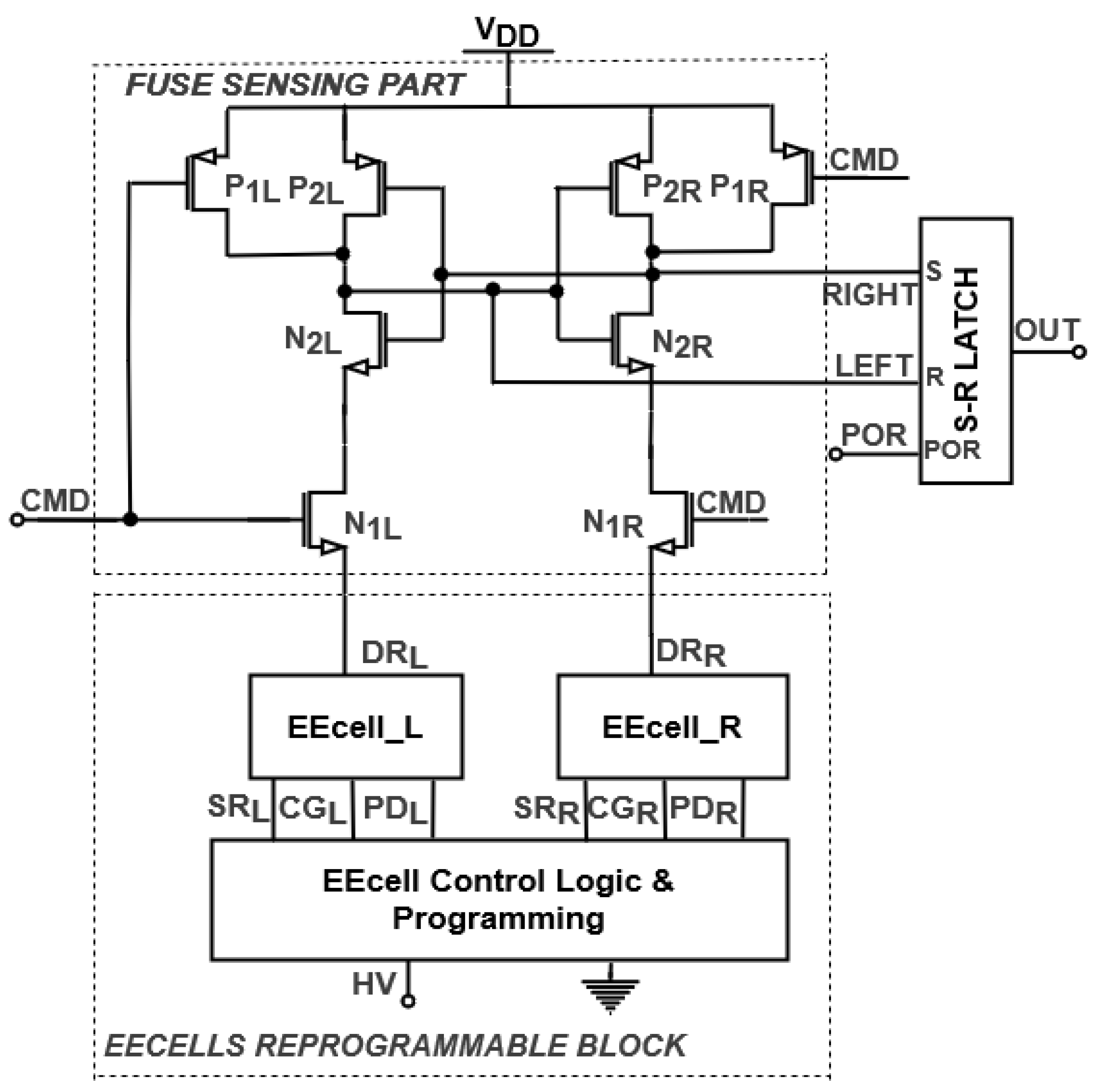
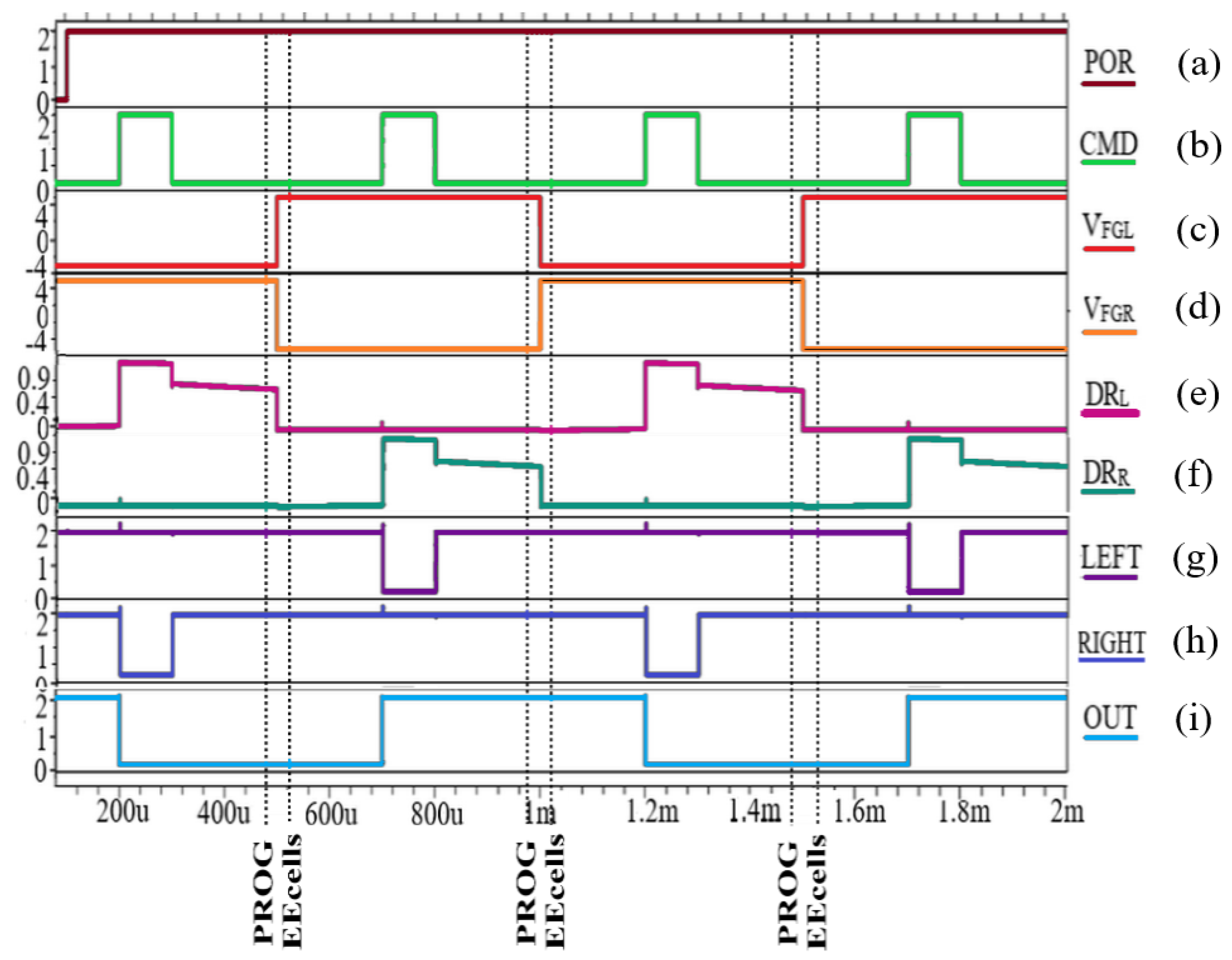
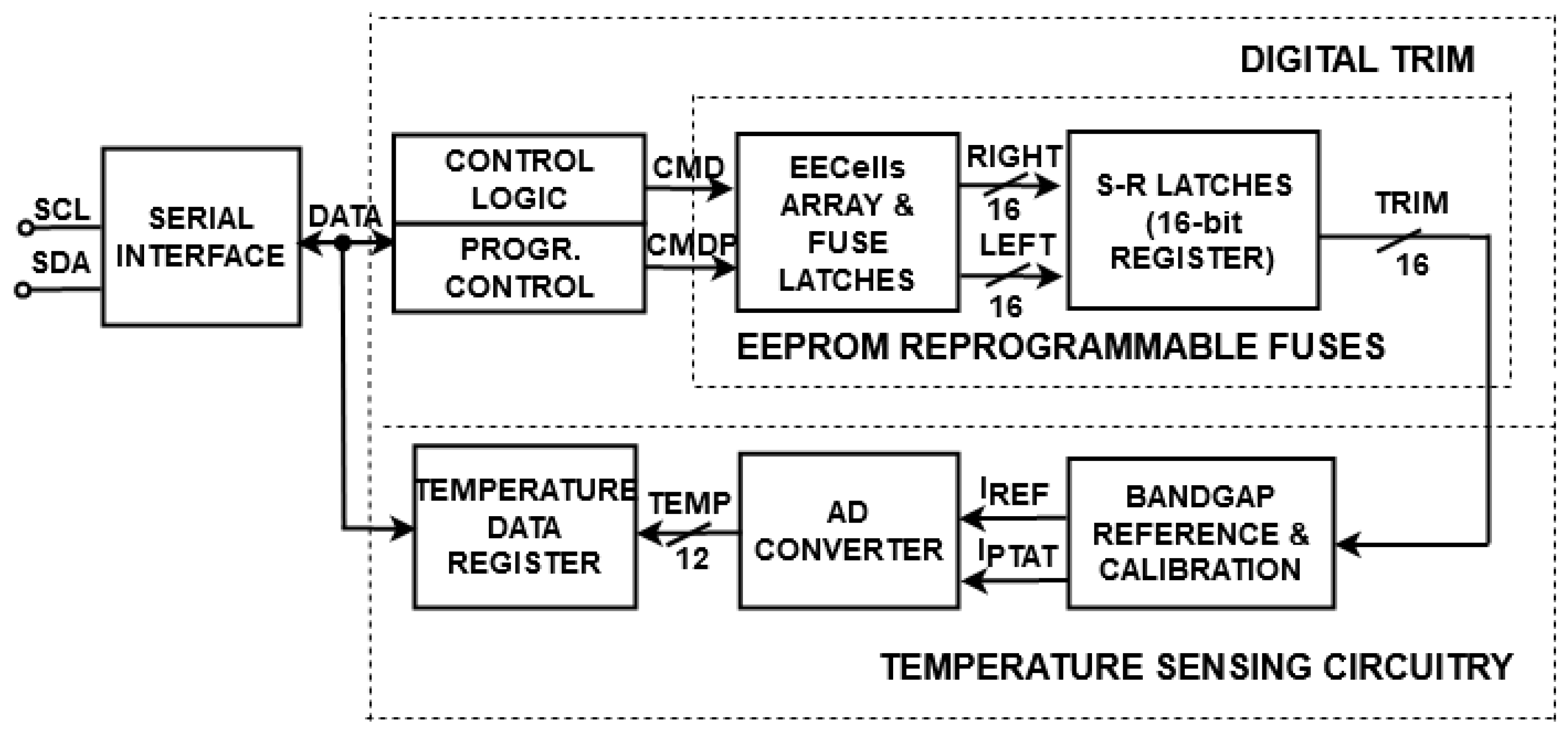
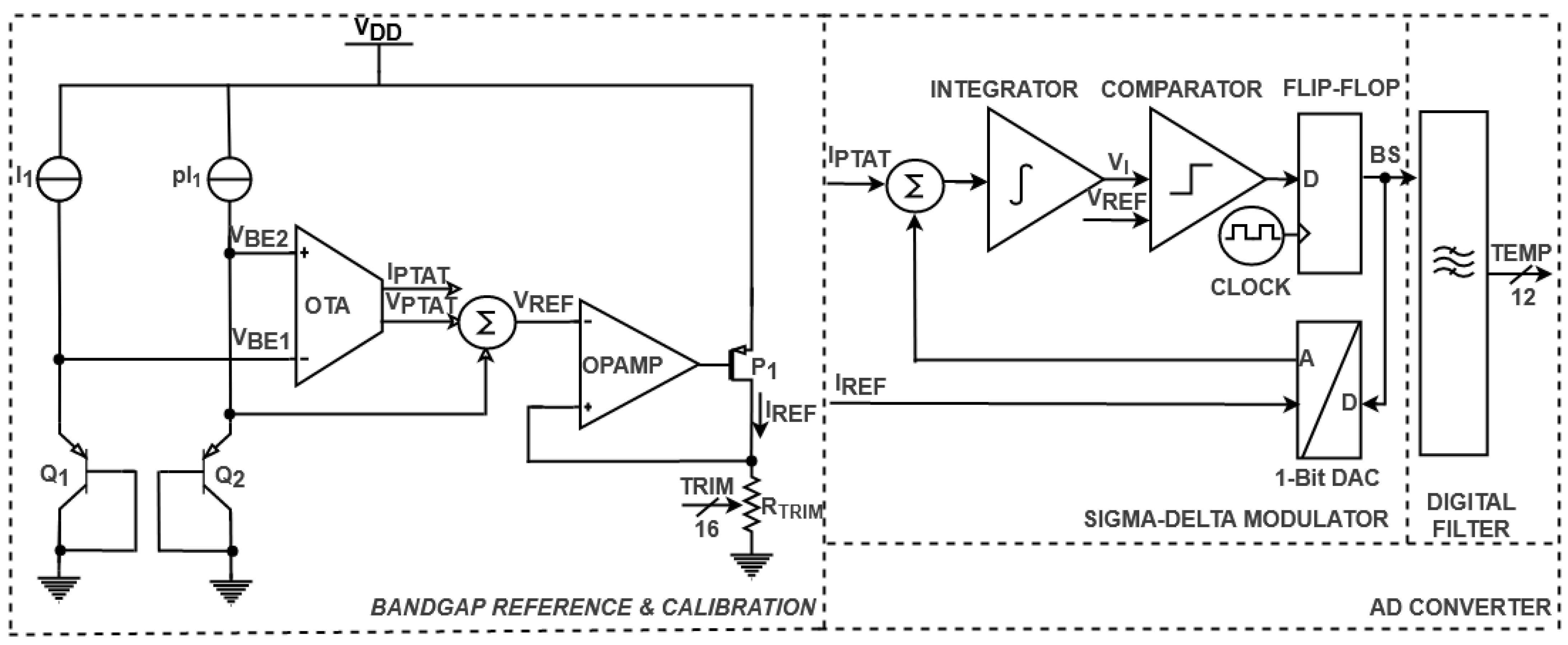
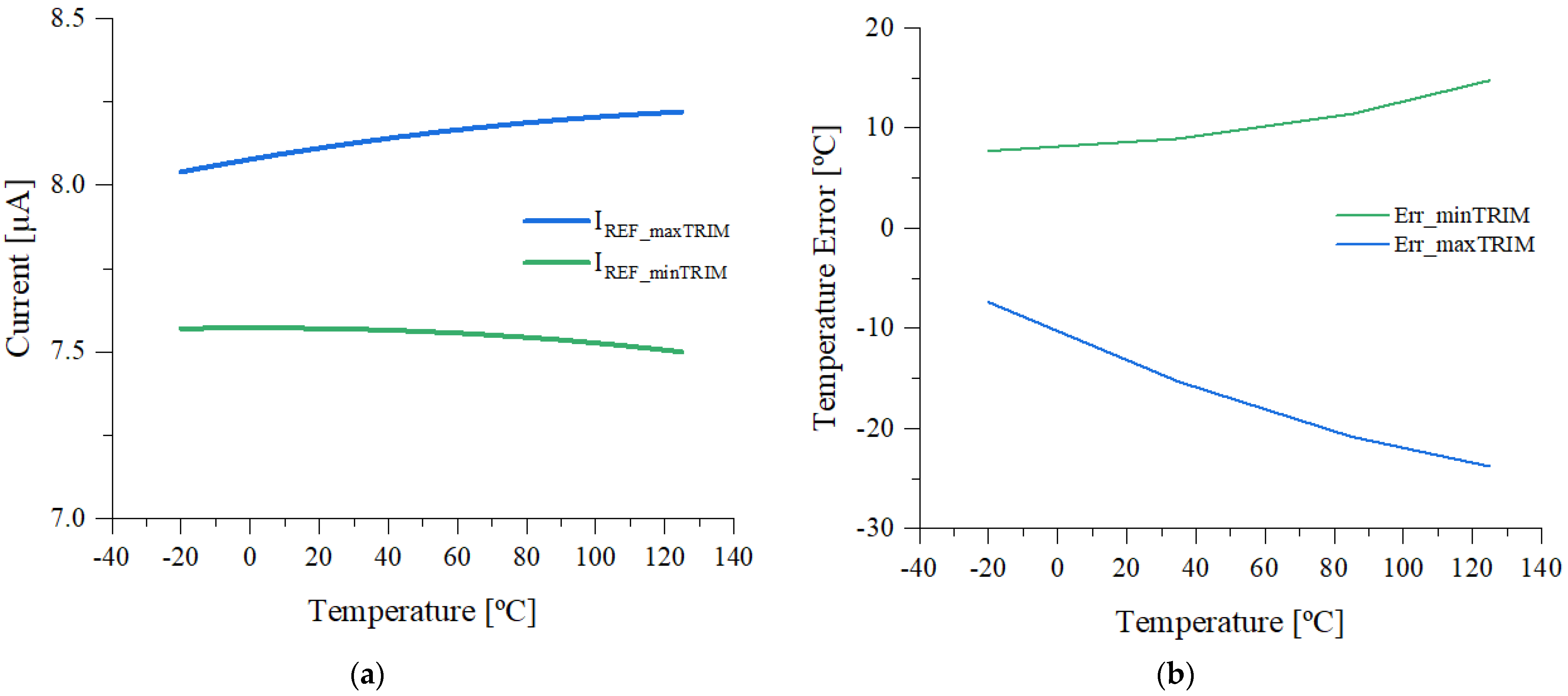
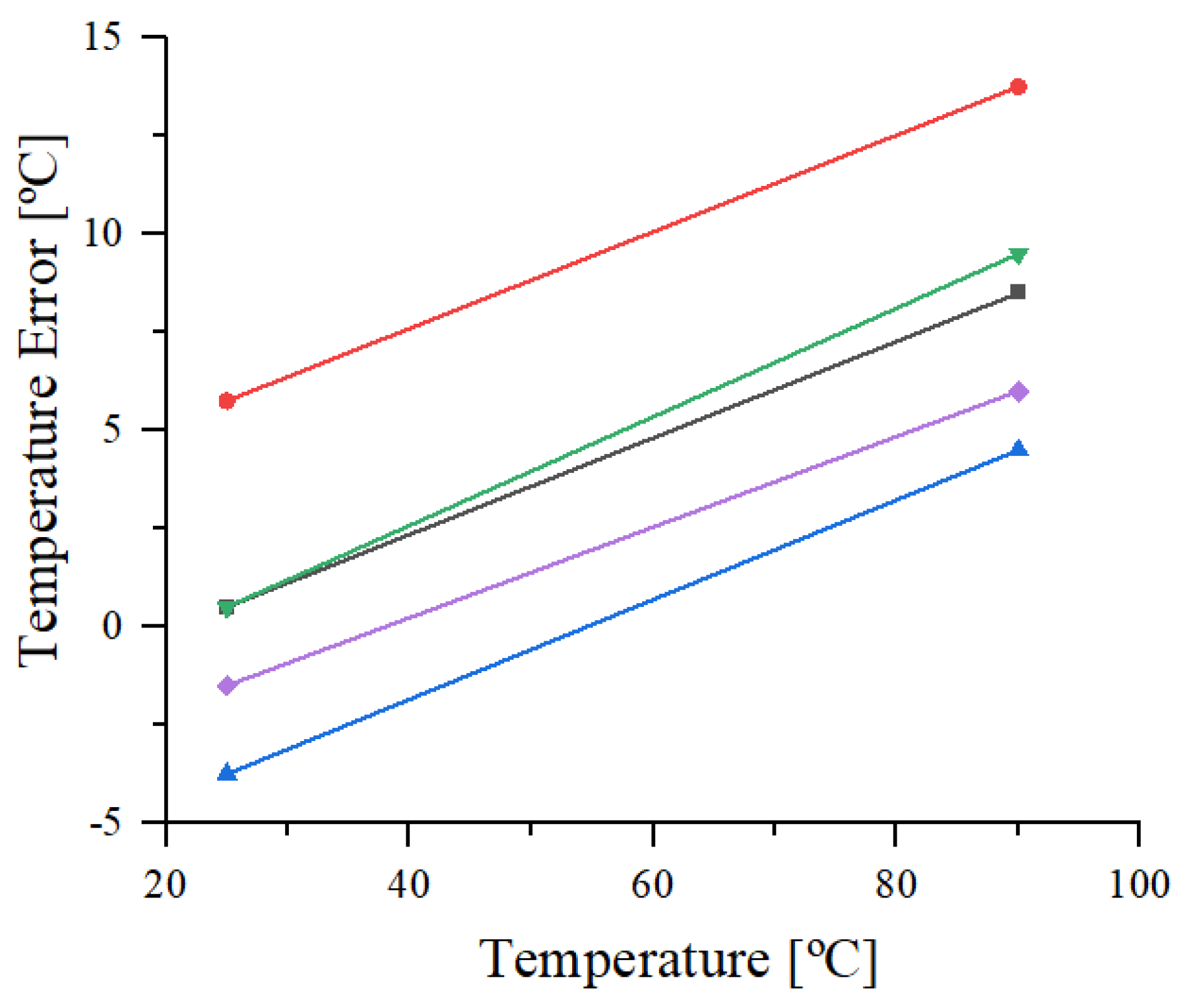
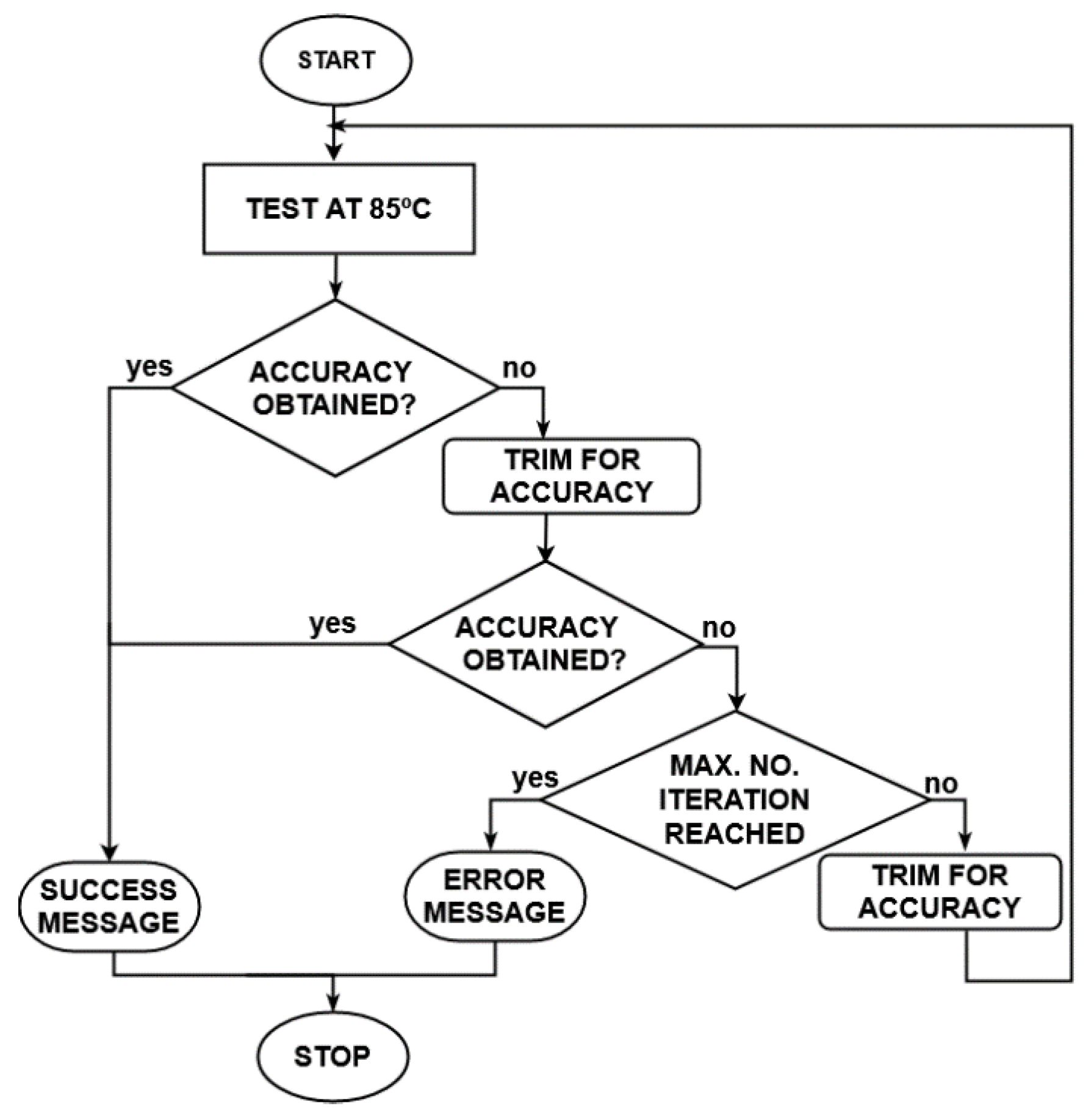


| Parameter | Power Supply [V] | Temperature Range [°C] −20~125 |
|---|---|---|
| Mean [°C] | 1.7 | 0.30 |
| 1.8 | 0.44 | |
| 1.9 | 0.35 | |
| Standard Deviation [°C] | 1.7 | 0.71 |
| 1.8 | 0.71 | |
| 1.9 | 0.69 |
| Type | Process [nm] | Power Supply [V] | Temperature Range [°C] | Inaccuracy [°C] | Calibration | No. Samples | Power [µW] | |
|---|---|---|---|---|---|---|---|---|
| This Work | BJT | 180 | 1.7~3.6 | −20~125 | +1.56/−1.0 | One point | 25 | 850 |
| [4] | TD | 55 | 0.8~1.3 | −40~125 | ±0.70 (3σ)/±0.94 (3σ) | Two points | 4 | 9.3 |
| −10~110 | ±1.38 (3σ)/±1.64 (3σ) | One point | 4 | 9.8 | ||||
| [5] | CIS pixels | 180 | 3.3 | −20~80 | ±1.30 (3σ) | Two points | 3 | 36 |
| [6] | CIS pixels | 180 | 3.3 | 0~100 | ±1.40 (3σ) | Two points | 3 | 144 |
| [7] | MOS | 130 | 1.3 | −20~85 | ±0.60(3σ) | Two points | 10 | 6 |
| [8] | TD | 130 | 1.3 | −20~85 | ±0.60 (3σ) | Two points | 10 | 6 |
| [9] | MOS | 180 | 1.0 | 0~100 | +0.29/−0.98 | Two points | 10 | 22.3 |
| [10] | BJT | 160 | 1.8 | −40~180 | ±0.25 (3σ) | One point | 24 | 9.75 |
| [11] | MOS | 350 | 3.3 | 0~90 | +0.7/−1.35 | Two points | 3 | 3000 |
| [12] | BJT | 180 | - | 16~87 | +0.68/−0.8 | One point | 3 | 586 |
| [13] | RES | 65 | 0.6~1.0 | −20~120 | ±1.5 (3σ)/0.80 (3σ) | Two points | 16 | 0.1 |
| [14] | RES | 65 | 0.6~1.2 | −45~85 | +1.6/−1.0 | Two points | 8 | 47.2 |
| ±4 | One point | 8 | ||||||
| [15] | RES | 65 | 1.0 | 0~100 | +1.5/−1.1 | One point | 12 | 36 |
| [16] | BJT&MOS | 22 | 1.0 | −30~120 | ±1.07 (3σ) | One point | 38 | 50 |
| [17] | TD | 180 | 1.2 | −40~120 | +1.0/−1.0 | One point | 4 | 3 |
| [18] | BJT | 14 | 1.35 | 0~100 | +1.0/−1.5 | Two points | 52 | 1600 |
| [19] | MOS | 60 | 1.0 | 20~80 | ±3 | One point | 4 | 14 |
| [20] | BJT | - | 3.0~5.5 | −20 ~55 | ±0.15 | Two points | 14 | - |
| [21] | MOS | 180 | 0.8 | −20 ~80 | +1.2/−0.9 | Two points | 9 | 11 |
| [22] | BJT | 180 | 1.8 | −55 ~125 | ±0.3 (3σ) | Two points | 20 | 8280 |
| [23] | BJT | 180 | 1.8–5.5 | 20 ~50 | ±0.1 (3σ) | One point | 15 | 16 |
| [24] | MOS | 180 | 1.2 | 0~100 | +1.5/−1.4 | Two points | 4 | 0.071 |
| [25] | RES | 65 | 0.83–1.35 | −50~105 | ±1.2 (3σ) | One point | 20 | 32.5 |
Publisher’s Note: MDPI stays neutral with regard to jurisdictional claims in published maps and institutional affiliations. |
© 2021 by the authors. Licensee MDPI, Basel, Switzerland. This article is an open access article distributed under the terms and conditions of the Creative Commons Attribution (CC BY) license (http://creativecommons.org/licenses/by/4.0/).
Share and Cite
Vasile, A.M.; Negut, A.; Tache, A.; Brezeanu, G. A Digital Improvement—Trimming a Digital Temperature Sensor with EEPROM Reprogrammable Fuses. Sensors 2021, 21, 1700. https://doi.org/10.3390/s21051700
Vasile AM, Negut A, Tache A, Brezeanu G. A Digital Improvement—Trimming a Digital Temperature Sensor with EEPROM Reprogrammable Fuses. Sensors. 2021; 21(5):1700. https://doi.org/10.3390/s21051700
Chicago/Turabian StyleVasile (Dragan), Anca Mihaela, Alina Negut, Adrian Tache, and Gheorghe Brezeanu. 2021. "A Digital Improvement—Trimming a Digital Temperature Sensor with EEPROM Reprogrammable Fuses" Sensors 21, no. 5: 1700. https://doi.org/10.3390/s21051700








